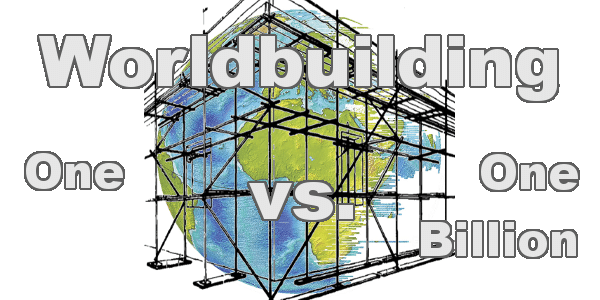There are over 7 billion people on Earth. Your story world may have more, it may have fewer, but unless you are writing a creation myth, you’re talking very large numbers of people both alive and historical. Though few of them had any idea they were doing it, each was taking part in shaping their world. Art, architecture, cooking, religion, and entertainment — they were built from the ground up, organically, over vast periods of time.
What are the odds that you can match that feat in your writing? You want to create a world that looks and feels like a real place. You want a world that the reader can believe in. But you can’t compete with 7 billion people, most of whom aren’t aware of what they’re doing. You probably can’t compete with a thousand. Good news: it’s not a competition. Better news: you don’t have to try.
No matter how thick a novel, it’s only a tiny window onto the whole of a world. How can you take advantage of this to make a real-seeming world?
Control the Camera
You tell a story from a certain point of view (POV). That POV colors everything by its perspective. What does the POV character see, feel, and think of his or her world? Imagine a major disaster — a tsunami. You can tell a story about it from the perspective of a fisherman whose boat was in the water when the wave came. You could also tell it from a fire chief leading rescue efforts. Or you could tell it from the perspective of a foreign volunteer preparing to take a trip to aid in relief efforts.
Imagine how differently each would view the world, and how different the same world might look to each of them. To the fisherman, this might well be the apocalypse. He’s going to be in a fight for his life, and even if he survives, his home will be devastated. And what of his family?
For the fire chief, this could be a legacy creation story. All his life has been leading to this moment. These people are depending on him, and his every decision could be a matter of live and death for hundreds of people. The responders he commands will get the front-line view, but from the command center, the disaster is a series of reports and images: he can’t afford to be out there. If you were an outsider to our world, reading a story about it, you’d see the sense of duty, the burden of command, and the technology we use to deal with disasters.
The volunteer comes in after the danger is over. Her world is filled with distributing food and blankets, directing people to shelters, collecting information about missing relatives, and preventing outbreaks of disease due to unsanitary conditions. Her presence alone is a key worldbuilding point: people care enough to help those who they’ve never met. Does she witness looting or a community coming together, despair or a resolve to rebuild? All are valid, and each gives a reader a different look at the same world.
It all comes down to where you point the camera as to what your reader sees.
Attention to Detail
A human body has 37 trillion cells. Nowhere in the history of literature has anyone described a human in a level of detail that comes close to matching that. So how do you describe a person? You describe a feature here or there that separates them from the other humans around them.
The same goes for worlds. If your fantasy world is a vibrant, exotic world, don’t spend time talking about things common to our own world. Skip the granite and oak, and tell the reader about the magicite and dragonwood. Don’t dwell on the armored knights, but describe the descended angel that guards the king.
By the same token, be specific. Wood, stone, and metal aren’t things. They are types of thing. Using those three bland descriptors can be fine if you want to give a quick sense of something, but by calling them what they really are (or what the POV character best guesses them to be) adds to your world building.
Not…
- A wooden door
- A stone tower
- A metal sword
Instead…
- A weathered oaken door
- A tower of black marble
- A sword forged of a mysterious pale red metal that is always warm to the touch
Detail, applied judiciously, can push and pull, making the unique parts of your world prominent, while relegating the boring, everyday parts to your readers’ imaginations to fill out.
Just remember… you’re outnumbered. Don’t try to do the worldbuilding work of an entire civilization. Just trick your reader into thinking you did.


0 Comments